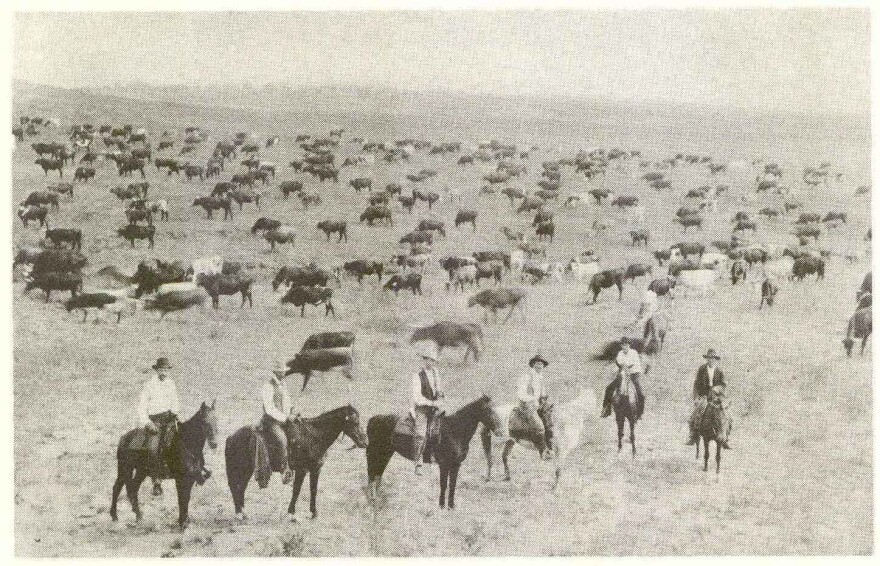As citizens across the country celebrate our nation’s independence tomorrow, the High Plains Western Heritage Center is also putting time aside to recognize the American Cowboy. We visited the Spearfish museum to learn what it was like to raise cattle for a living and to discuss efforts by a 9-state coalition to mark the historic trail that brought cattle north from Texas to South Dakota and beyond.
During the late 1950s and early 1960s, it was difficult to turn on a TV and not come across images of cowboys riding across the small screen. At one time, there were 26 Westerns airing during prime-time: Bonanza, Wanted: Dead or Alive, Wagon Train, Gunsmoke…the list goes on.
Add to this the hundreds of Western films that ran on late night TV and on Saturday afternoons and it was pretty much “cowboy country” from the West coast to the East.
But as much as this film genre was a means of entertainment for the masses, High Plains Western Heritage Center executive director Peggy Ables says the subject matter was based on a topic that was real, easily recognized and widely respected.
“There’s very few people you’ll meet that say, ‘I don’t like Western,” she observes. “ ‘Cause I think about everybody does…or at least they’ll sit through one, ya’ know. But I think that it’s an excellent idea to have a Day of the American Cowboy. And we’ve done an event every year in the summer to recognize the Day of the American Cowboy.”
This year’s event honors the Great Western Cattle Trail and takes place a few weeks shy of the July twenty-sixth date set aside by Congress to honor those men – and women – whose lives in the American West contributed to the country’s survival as well as its history and unique culture.

Sitting on the stage of the High Plains Western Heritage Center…set up with straw bales, electrically illuminated “flames” and a nearby chuck wagon to recreate a cowboy campfire somewhere in the West, Peggy Ables explains just what the Great Western Cattle Trail was. She first reads from a flyer that tells the story.
“The mass departure of cattle started after the Civil War,” says Ables.”When Texans returned home to find too many rogue cattle and not enough grass. As a result, they organized trail drives to move cattle from Texas into Kansas and eventually north to the nutritious short grass of the high plains…where open range cattle operations were established.”
This area’s short grass, explains Ables, was crucial to the growing post-Civil War cattle industry.
‘It’s because our grass goes dormant earlier because of our long winter season…but it traps the nutrients. It doesn’t look like it’s as much grass because it’s not as high…but it’s as good a grass as you can get. Those first herds gained weight like crazy. So those cowboys went back and said ‘This is what you want to do to finish out your longhorns.”
Peggy Ables notes that cattle herded north to the high plains were shipped to cities on the East coast to satisfy the high beef demand. They were also sent to Native American reservations and military posts as well as being sold to settlers and miners.
“At one time in the early 1890s, they shipped more cattle out of Belle Fourche, South Dakota than any other shipping point in the world,” Ables comments.

Efforts to identify the general route of the Great Western Cattle Trail began in 2003, when the first concrete marker was set and dedicated at Altus, Oklahoma just north of the Red River. Since that time, official markers have been placed from Texas to Ogallala, Nebraska with plans to dedicate two more this weekend in Belle Fourche and Spearfish. The goal is to mark the entire trail north into Montana.
Yet, this year’s National Cowboy Day celebration at the High Plains Western Heritage Center is about more than the Great Western Cattle Trail. It’s about the cowboys who moved cattle along that route and the pioneers who created ranches as a result of it, establishing a lifestyle, says Peggy Ables that was anything but glamorous.
“The fact is that ranchers were hardworking, tough people,’ she explains. “And they weren’t riding into town to get in a fight. They were riding out in the pasture to find out if the cow was ready to calf. And women were a significant part of setting up a homestead, a ranch…whatever you intended to do…it was a team effort.”
Anyone who didn’t follow that script, says Peggy Ables, usually didn’t make it. The ceaseless high-plains winds battering on un-insulated one-room houses also drove many a would-be rancher packing. Those who were able to tough it out, adds Peggy Ables, were the forefathers of those who still carry on the ranching tradition today.
The introduction of modern conveniences notwithstanding, a rancher’s life is still not for the faint-of- heart. That’s why Peggy Ables makes it a point to celebrate the American Cowboy every year – to remind people – especially those who live on the high plains, who came before them.
For info on National Cowboy Day at the High Plains Western Heritage Center:
http://www.westernheritagecenter.com/
Songs in this story:
Theme to Bonanza
https://www.youtube.com/watch?v=mjdRgBAY278
My Baby Loves the Western Movie
https://www.youtube.com/watch?v=fxontg0irEQ
Theme to The Magnificent Seven
https://www.youtube.com/watch?v=8XDB7GMnbUQ
Theme from The Searchers
https://www.youtube.com/watch?v=20jAtWu4CxM
*** "Tumbling Tumbleweeds" and "Across the Wide Missouri" from "West of the Pecos" - A Classic Collection of Great American Cowboy Songs - with Jim Hendricks


